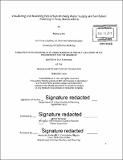| dc.contributor.advisor | James Wescoat. | en_US |
| dc.contributor.author | Hui, Rebecca (Rebecca C.) | en_US |
| dc.contributor.other | Massachusetts Institute of Technology. Department of Urban Studies and Planning. | en_US |
| dc.coverage.spatial | a-ii--- | en_US |
| dc.date.accessioned | 2018-05-23T16:30:31Z | |
| dc.date.available | 2018-05-23T16:30:31Z | |
| dc.date.copyright | 2018 | en_US |
| dc.date.issued | 2018 | en_US |
| dc.identifier.uri | http://hdl.handle.net/1721.1/115692 | |
| dc.description | Thesis: M.C.P., Massachusetts Institute of Technology, Department of Urban Studies and Planning, 2018. | en_US |
| dc.description | Cataloged from PDF version of thesis. Page 128 blank. | en_US |
| dc.description | Includes bibliographical references (pages 116-127). | en_US |
| dc.description.abstract | As cities grow and rural fringes are urbanized, an in-between village state is emerging, that scholars are attempting to categorize as "Peri-Urban". Yet there are no existing models to quantify the population movements, infrastructure needs, and social characteristics of this rapidly emerging condition. The lack of diagnosis for the Peri-Urban State leads to uneven distribution of water resources, pollution of surface and groundwater, and unclear administrative lines. This thesis presents a dialectical field research and Census data mapping approach for visualizing peri-urban and rurban patterns at the district (Zilla Parishad) scale using Pune district in Maharashtra as a case study. We adapt Census of India demographic definitions of the rural-urban dichotomy along with distance-based definitions used in Maharashtra, and compare them with Census data on water and sanitation services. Our key findings from our research are the following: From interviews with village Gram Panchayats, we create a framework for identifying peri-urban drivers and processes. Through GIS spatial analysis, we identify extensive settlement patterns and size relationships with access to amenities. District field research and interviews identified village concerns associated with four main spatial processes of peri-urbanization in Pune district: i) megacity growth; 2) highway corridor development; 3) industrial zone development; and 4) smaller block town (taluka) expansion. The analysis returned to the construction of 2 Indices for Pune Zilla Parishad: The Water Supply and Waste Index, and a Dire Situations Index. These findings and maps were then reviewed by the Pune Zilla Parishad, Maharashtra State Government, and the Maharashtra Industrial Development Corporation for feedback. Our frameworks are being evaluated for integration into Maharashtra's long-term water strategic planning. New, annually updated water and sanitation datasets at the national and state levels will make this combination of field and mapping research increasingly valuable for visualizing regional peri-urban and rurban conditions in the districts of India. | en_US |
| dc.description.statementofresponsibility | by Rebecca Hui. | en_US |
| dc.format.extent | 128 pages | en_US |
| dc.language.iso | eng | en_US |
| dc.publisher | Massachusetts Institute of Technology | en_US |
| dc.rights | MIT theses are protected by copyright. They may be viewed, downloaded, or printed from this source but further reproduction or distribution in any format is prohibited without written permission. | en_US |
| dc.rights.uri | http://dspace.mit.edu/handle/1721.1/7582 | en_US |
| dc.subject | Urban Studies and Planning. | en_US |
| dc.title | Visualizing and modeling Peri-Urban drinking water supply and planning in Pune, Maharashtra | en_US |
| dc.type | Thesis | en_US |
| dc.description.degree | M.C.P. | en_US |
| dc.contributor.department | Massachusetts Institute of Technology. Department of Urban Studies and Planning | |
| dc.identifier.oclc | 1036985763 | en_US |
